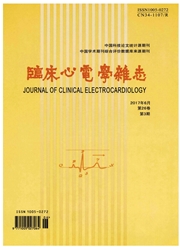

 中文摘要:
中文摘要:
目的评价合并心力衰竭的常规起搏器患者升级为CRT逆转左室重构的作用。方法入选起搏依赖、合并心力衰竭的常规起搏器患者,将其升级为CRT。观察手术前后患者QRS时限、左室舒张末期内径(LVEDD)、射血分数(LVEF)与肺动脉收缩压(SPAP)等心脏结构和功能的变化情况。结果常规起搏器升级为CRT后,QRS时限较前明显缩短,由术前的155.2±27.1ms缩短至130±15.0ms,p〈0.01。随访至术后6月,CRT有效率为68%(18/25例),LVEDD[(64.6±8.5)vs(57.56±9.5),p〈0.01]显著缩小,LVEF[(29.4±3.8)vs(32.5±4.1),p〈0.01]显著增加,SPAP[(46.6±12.8)vs(44.5±13.1),p〈0.01]也较前下降。结论对于起搏依赖、合并心力衰竭的常规起搏器患者,升级为CRT可显著改善心功能、逆转心肌重构。
 英文摘要:
英文摘要:
Objective To evaluate the benefit of cardiac resynehronization therapy(CRT)in patients with chronically right ventricle paced heart failure. Methods We studied patients who had a previously implanted pacemaker, They were chronically RVpaced resulted in a tremendous LV function deterioration an treated by upgrading to CRT or CRT-D. To observe the changes of the baseline character including ORS duration,and echocardiography parameters at least 6 months after upgrading to CRT or CRT-D. Result CRT significantly reduced the mean QRS duration [(155.2 ±27.1ms) vs(130 ±15.0ms),p0.05], reduced the left ventricular end-diastolic dimensions [(64.6±8.5) vs(57.56±9.5), p0.01] and pulmonary artery systolic pressure[(46.6±12.8) vs(44.5±13.1),p0.01]. The LV ejection fraction[(29.4±3.8) vs(32.5±4.1), p0.01] were increased observably, and we found that the effective rate of CRT was 68%(18/25). Conclusion For patients with pacemaker dependent and merge heart failure in conventional pacemaker, upgraded to a reverse CRT can significantly improve cardiac function and myocardial remodeling.
 同期刊论文项目
同期刊论文项目
 同项目期刊论文
同项目期刊论文
 期刊信息
期刊信息
